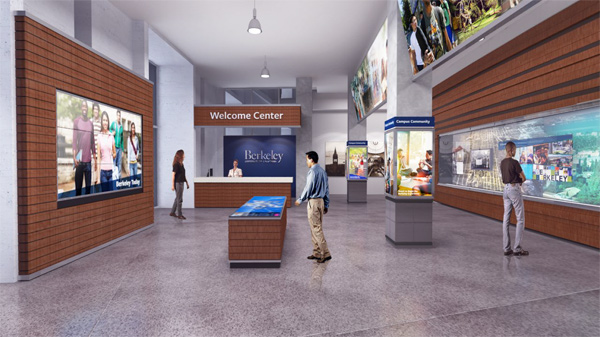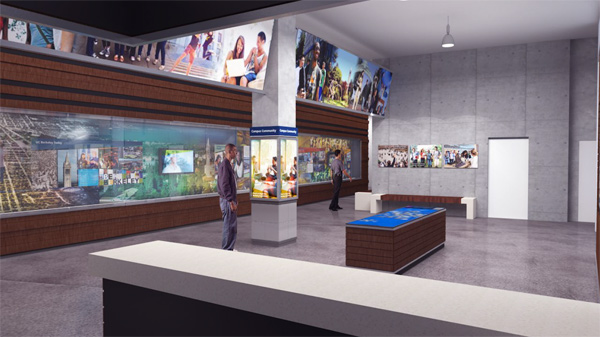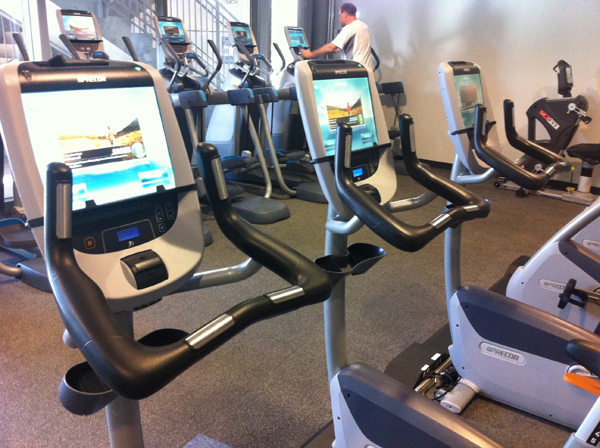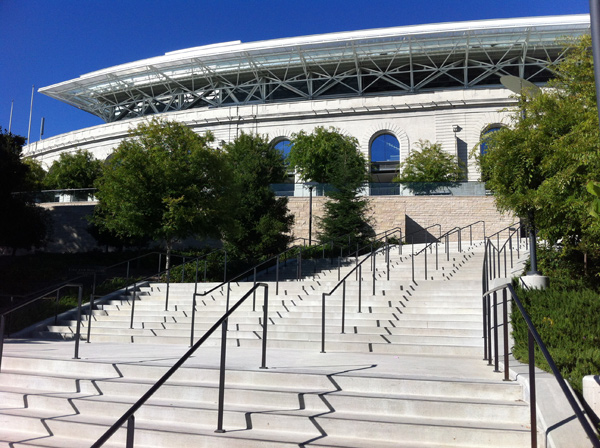New campus gateway emerging at Memorial Stadium
An innovative plan is underway to turn California Memorial Stadium into a multi-use building for academic and athletic activities and a scenic gateway for the Berkeley campus.

March 17, 2014
By next fall, California Memorial Stadium not only will be bustling on football game days, but busy all week as a vibrant new campus gateway and a multi-use building filled with both academic and athletic activities. Classrooms, an auditorium, food vendors, a student store, a fitness center and more will inhabit the stadium, which reopened in August 2012 after a $321 million renovation.
In addition, campus tours will originate from a scenic new home for the UC Berkeley Visitor Center, which serves more than 150,000 people a year. The spectacular views of UC Berkeley and the Bay Area from the stadium’s club levels will continue to be enjoyed by private, corporate and campus groups that since fall 2012 have rented them for more than 180 special events.
The refurbishment and retrofitting of the 90-year-old stadium, and the creation of the adjacent 1.5-acre Lisa and Douglas Goldman Plaza, was done to create a safer and more modern sports venue, and also to open the eastern part of UC Berkeley to the entire community, said Bob Lalanne, who became UC Berkeley’s first vice chancellor for real estate last December.
“Our whole objective was to take this beautiful, historic building and make it more of a campus community asset 365 days of the year, rather than just for seven game days. The way Lower Sproul Plaza is being turned into a new living room for the campus, this space will essentially become ‘Sproul Plaza East,'” he said. The project, which will roll out over two years’ time, is a joint effort between Lalanne and Vice Chancellor for Administration and Finance John Wilton.
Last year, a campus committee – the California Memorial Stadium Visioning Committee – was appointed by Wilton to explore innovative ways to turn the stadium into a multi-use facility, and its work is beginning to pay off – as is the rent from tenants and others that will help to defray the stadium’s costs.
“Our new financial approach to paying for the new facilities incorporates a strategic focus on the diversification of revenue sources to reduce dependency on core sports,” said Wilton, “and thereby increase financial stability over the long term.”
Innovative campus tenants
Last September, the first academic tenant of the stadium moved into a space on the ground floor and just off the plaza. The Berkeley-Haas Innovation Lab, or I-Lab, opened across the street from the Haas School of Business in a 2,700-square-foot open classroom with furniture and partition walls that can be easily reconfigured to help students best engage in experiential and collaborative activities.
Soon afterward, the 5,000-square-foot Recreational Sports Fitness Center at Memorial Stadium opened a few doors down from the I-Lab as a satellite to the Rec Sports facility on Bancroft Way. Just as the I-Lab is innovative space, the fitness center features fitness equipment accessible to all, including those with limited mobility, and private, gender-neutral changing rooms and showers.
“The stadium is all about innovation and excellence,” said Lalanne, also touting the two-year-old Simpson Center for Student-Athlete High Performance, a state-of-the-art training center at the stadium for all UC Berkeley student-athletes and home to 13 intercollegiate teams. “Each new tenant moving in will reinforce these themes.”
Another new tenant will be the Richard and Rhoda Goldman School of Public Policy, scheduled to open a space on the stadium’s fourth floor for its development and public affairs staff, its executive education program and for some of its centers and Ph.D. students.
“It’s exciting that we’ll be near the Visitor Center, a place that will be an active hub for the campus. It is also great to be near the law and business schools, and in a place where there will be a shared auditorium,” said public policy dean Henry Brady. “We look forward to interacting with others in that eastern part of campus and to finding ways to make it a vibrant and educationally stimulating place for Berkeley.”
Lalanne said his office is in discussion with several other academic units about renting spaces in the stadium, and that a building manager for the stadium would soon be hired.
A hub for visitors far and wide
Another new stadium tenant will be UC Berkeley Visitor and Parent Services, part of the Office of Communications and Public Affairs.
For La Dawn Duvall, executive director of Visitor and Parent Services, a state-of-the-art welcome center for campus guests, including prospective students and their families, is “necessary, overdue and completes what a visit to a university should be. Along with visitors to the Campanile, we serve 150,000 to 160,000 people a year, and that’s a huge number of people getting a first impression of Berkeley. And first impressions count for so much.”
The Visitor Center has hung its hat in several humble spaces over the years, including a tiny spot in the student union, a slice of University Hall’s ground floor, and then an office on the first floor of Sproul Hall, its current home.
At the center’s next location, “the guests’ experience will be on par with the academic excellence of the campus,” Duvall said, adding that the large number of tourists will help bring in revenue for the stadium through purchases of food and souvenirs.
Guests who visit the club levels in the stadium will learn more about the extraordinary campus through proposed installations, including an enhanced Cal Athletic Hall of Fame and exhibits that highlight campus Nobel Prize winners and others from UC Berkeley who have made major contributions to society, said Lalanne.
A two-level parking garage being built below Maxwell Field, which is adjacent to the stadium, will make visiting the venue easier. It will replace hundreds of spaces lost during the renovation and other construction projects in the area. The playing field will be rebuilt on top of the new parking structure.
Athletic Director Sandy Barbour said that a collective vision at UC Berkeley of turning the stadium into a year-round, multi-use facility “is becoming a reality, thanks to strategic partnerships across campus. Whenever you have an opportunity to bring academic, athletic, larger campus and greater Bay Area communities together, that has positive impacts.”
“In the short time since the renovation,” she said, “this incredible space continues to serve as a hub for activity connecting those communities, and we believe it will do so for years to come.”




